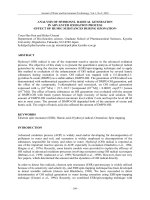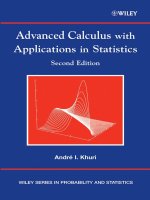Advanced in Hetorocylic Chemsistry
Bạn đang xem bản rút gọn của tài liệu. Xem và tải ngay bản đầy đủ của tài liệu tại đây (12.86 MB, 369 trang )
Advances in
Heterocyclic
Chemistry
Volume 55
www.pdfgrip.com
Editorial Advisory Board
R. A. Abramovitch, Clemson, South Carolina
A. T. Balaban, Bucharest, Romania
A. J. Boulton, Norwich, England
H. Dorn, Berlin-Bohnsdorf, Germany
J . Elguero, Madrid, Spain
S. Gronowitz, Lund, Sweden
0. Meth-Cohn, Sunderland, England
C. W. Rees, FRS, London, England
E. C . Taylor, Princeton, New Jersey
M. TiSler, Ljubljana, Slovenia
J. A. Zoltewicz, Gainesville, Florida
www.pdfgrip.com
Advances in
HETEROCYCLIC
CHEMISTRY
Edited by
ALAN R. KATRITZKY, FRS
Kenan Professor of Chemistry
Department of Chemistry
University of Florida
Gainesville, Florida
Volume 55
ACADEMIC PRESS, INC.
Harcourt Brace Jovanovich, Publishers
San Diego New York Boston
London Sydney Tokyo Toronto
www.pdfgrip.com
This book is printed on acid-free paper. @
Copyright 0 1992 by ACADEMIC PRESS, INC.
All Rights Reserved.
No part of this publication may be reproduced or transmitted in any form or by any
means,electronic or mechanical, including photocopy, recording, or any information
storage and retrieval system, without permission in writing from the publisher.
Academic Press, Inc.
1250 Sixth Avenue, San Diego, Califomia92101-4311
United Kingdom Edition published by
Academic Press Limited
24-28 Oval Road, London NWl 7DX
Library of Congress Catalog Number: 62-13037
International Standard Book Number: 0-12-020755-9
PRINTED IN THE UNITED STATES OF AMERICA
929394959691
BC
9 8 1 6 5 4 3 2 1
www.pdfgrip.com
Contents
CONTRIBUTORS
...............................................................
PREFACE
.....................................................................
vii
ix
Heterocyclic Synthesis Using New Heterodienophiles
MARTIN
R. BRYCE,
JAN BECHER,
A N D BIRGITTE
FALT-HANSEN
I.
11.
111.
IV.
V.
VI.
Overview.. .........................
...............
Thioaldehydes, RCH=S .................................
Selenoaldehydes, RCH=Se
..................................
Telluraldehydes, RCH=Te ..............................
Thionitroso Compounds, RN
Selenonitroso Compounds, RN= Se . .
...............
References
.......................................
2
2
14
19
19
24
24
The Literature of Heterocyclic Chemistry, Part IV
L. I. BELEN’KII
AND N. D. KRUCHKOVSKAYA
..................
IV. Four-Membered Rings
...............
.....................
VII. Rings with More Than Six Members
VIII. Heterocycles Containing Unusual He
References . . . . . .
ms ...........
..................................
36
31
59
61
62
13
82
86
91
Uracils: Versatile Starting Materials in Heterocyclic Synthesis
HEINRICH
WAMHOFF,
JORG DZENIS,
A N D KOSAKU
HIROTA
I . Introduction.. .........................................................
11. Structure and Physical Properties. ......................................
111. Naturally Occurring Uracils; Uracils as Active Principles . . . . . . . . . . . . . . . .
V
www.pdfgrip.com
130
I30
132
vi
CONTENTS
IV .
V.
VI .
VII
VIII .
.
IX .
X
.
XI .
XI1 .
XI11 .
Uracil Syntheses .......................................................
1.3.Dimethyluracil as a Model Compound ...............................
Photoreactions of Uracils and Their Derivatives .........................
Annulation Reactions to the Intact Uracil Molecule .....................
Cycloaddition Reactions to the 5 .6-Double Bond; Ring Enlargement
Reactions ..............................................................
Bi.. Tri-. and Oligocyclic Systems Resulting from Uracils ................
Dimethyluracil as a Dimethylurea-Bridged Equivalent of a. @-Unsaturated
Carbonyl Moieties-Ring Transformations ..............................
Photoinduced Electrocyclizations and Radical Reactions of 1.3.
Dimethyluracils ........................................................
Novel Cleavage and Transformation Reactions of 6-Aminouracils ........
Conclusions ...........................................................
References ....................................................
...
134
140
141
151
196
198
212
226
230
236
231
Polycyclic Aromatic Nitrogen Cations
SADAO
ARAIAND MITSUHIKO
HIDA
I . Introduction and Scope ................................................
I1 . Polycyclic Aromatic Nitrogen Cation Systems ...........................
I11 . Theoretical Aspects of Polycyclic Aromatic Nitrogen Cation Systems ....
IV . Syntheses .............................................................
V . Structures and Physical Properties ......................................
VI . Reactivity .............................................................
VII . Useful Applications of Polycyclic Aromatic Nitrogen Cations ............
References ............................................................
www.pdfgrip.com
262
263
269
278
320
342
351
352
Contributors
Numbers in parentheses indicate the pages on which the authors’ contributions
begin.
Sadao Arai (261), Department of Industrial Chemistry, Faculty of Technology,
Tokyo Metropolitan University, Tokyo 192-03, Japan
Jan Becher ( I ) , Department of Chemistry, Odense University, DK-5230 Odense,
Denmark
L. I. Belen’kii (31), N. D. Zelinsky Institute of Organic Chemistry, Russian Academy of Sciences, Moscow, Russia
Martin R. Bryce ( l ) , Department of Chemistry, University of Durham, Durham
DH1 3LE, United Kingdom
Jorg Dzenis (129), Institut fur Organische Chemie und Biochemie der Universitat
Bonn, D-5300 Bonn I , Germany
Birgitte Falt-Hansen ( I ) , Department of Chemistry, Odense University, DK-5230
Odense, Denmark
Mitsuhiko Hida (261), Department of Industrial Chemistry, Faculty of Technology,
Tokyo Metropolitan University, Tokyo 192-03, Japan
Kosaku Hirota ( I 29), Department of Medicinal Chemistry, Gifu Pharmaceutical
University, Gifu 502, Japan
N. D. Kruchkovskaya (31), N . D. Zelinsky Institute of Organic Chemistry, Russian
Academy of Sciences, Moscow, Russia
Heinrich Wamhoff (129), Institut fur Organische Chemie und Biochemie der Universitat Bonn, D-5300 Bonn 1, Germany
vii
www.pdfgrip.com
This Page Intentionally Left Blank
www.pdfgrip.com
Preface
Martin Bryce, Jan Becher, and Birgitte Falt-Hansen provide a survey of
the behavior of thioaldehydes and their seleno and teleuro analogues, and
of thionitroso compounds and their seleno analogues, as heterodienophiles. This is a subject which has exploded in recent years with three
quarters of the references from the last decade.
L. I. Belen’kii and N. D. Kruchkovskaya have updated their survey of the
literature of heterocyclic review articles. This is the fourth installment in
this series: previous overviews of heterocyclic reviews appeared in Volumes 7 (literature up to 1963, 25 (literature 1966-1978) by S. M. Weeds
and P. M. Jones with your editor, and Volume 44 (literature 1979-1987) by
L. I. Belen’kii. A particular feature of this overview is its coverage of the
Russian language literature as well as Western sources.
Heinrich Wamhoff and Jorg Dzenis discuss the synthesis, structure, and
reactions of uracils with particular emphasis on their utility in heterocyclic
synthesis.
Finally, S. Arai and M. Hida review polycyclic aromatic nitrogen
cations containing bridgehead (ring fusion) nitrogen atoms. The chemistry
of quinolizinium salts was covered by Thyagarajan in Volume 5 of our
series back in 1965, and although other partial reviews are available, we
now have for the first time a modern comprehensive treatment.
A. R. KATRITZKY
ix
www.pdfgrip.com
This Page Intentionally Left Blank
www.pdfgrip.com
ADVANCES IN HETEROCYCLIC CHEMISTRY, VOL. 5 5
Heterocyclic Synthesis Using New
Heterodienophiles
MARTIN R. BRYCE
Depcirtment of Chemistry. Uniurrsitv c!fDiirkum.
Diirlium DHI 3 L E . Unitcd Kinpdom
JAN BECHER and BlRGlTTE FALT-HANSEN
.
Depurtment of Clirmistry Odrnsr Uniucwity
DK-5230 Odcwse. Dcwmrirk
.
I . Overview
4. I .2-Elimination Reactions . . . . . . . . . . . . . .
..............
13
C. Organometallic Selenoaldehyde Complexes: Synthesis and Reactivity. . . . .
IV. Telluraldehydes. RCH=Te
........................
V . Thionitroso Compounds. R
.........................
A . General Considerations . . . . . . . . . . . . . . . . .
.................
B. Preparative Methods and Reactions. . . . . . . .
I . Fragmentation of Sulfenamides
.......................
2 . Fragmentation of Heterocyclic
3. Ring Opening of 2. I-Benzisothiazoles . . . . . . . . . . . . . . .
VI. Selenonitroso Compounds. RN=Se . . . . . .
References . . . . . . . . .
............
......................
18
A . General Considerations . . . . . . . . . . . . .
B. Preparative Methods and Reactions. . . . . . . . . . . . . . .
19
?I
24
I
Copyright ,G IYY? by Academic Presh Inc.
All righl, oS reproduction in any Sorm r c w v e d .
www.pdfgrip.com
2
MARTIN R. BRYCE
el
a/.
[Sec. 1I.A
I. Overview
Heterodienophiles represent a very important class of compounds that
are enjoying considerable use in organic chemistry, especially for the
formation of heterocycles via cycloaddition reactions. A broad survey of
the chemistry of a large number of heterodienophiles has been published
(87MI1). This chapter focuses on the systems of the general formula
RX=Y (where X = CH or N; Y = S, Se, or Te; R = any substituent).
Most of these systems are transient intermediates that cannot be isolated.
It is only in the last few years that the chemistry of these systems has
been explored in a systematic way. Within this series of compounds,
thioaldehydes, RCH=S, are by far the most widely used in synthesis.
Preparative routes to selenoaldehydes and telluroaldehydes have invariably been developed in the light of previous work on the analogous thio
systems. The heavier chalcogens form the least stable systems, RCH=Y,
and good evidence for the generation of a telluraldehyde was not reported
until 1989.
A wide range of thionitroso compounds, RN=S, are now firmly established as reactive intermediates, yet many features of their chemistry
remain unexplored. Selenonitroso compounds, RN=Se, on the other
hand, have been observed only by spectroscopic techniques at very low
temperatures, and telluronitroso compounds remain undetected.
11. Thioaldehydes, RCH=S
A. GENERAL
CONSIDERATIONS
The synthesis and properties of thioaldehydes have been reviewed by
Russian workers (90UK649). Only recently in the 150-year history
(46CRV1; 57MI1; 79MI1) of the chemistry of thioaldehydes has the research emphasis in this area been on anything but their generation. Most
attempts to prepare thioaldehydes directly from the corresponding aldehydes using H,S led to trimers or oligomers. Simple thioaldehydes were
described as being so unstable that their monomeric forms could be detected only by spectroscopy or by trapping as Diels-Alder adducts. Later,
the first stable thioaldehydes were isolated as monomers. However, in
the early 1980s, several groups reported more general preparations of
thioaldehydes and described the use of thioaldehydes in organic synthesis.
In 1841, Laurent obtained thiobenzaldehyde decamer from reacting oil
of bitter almonds (which is mostly benzaldehyde) with ammonium sulfate
(1841LA320), although the size of the oligomer was not established until
www.pdfgrip.com
Sec. II.A]
SYNTHESIS USING HETERODIENOPHILES
3
50 years later (1891CB1431). In 1876, Klinger first identified the trimeric
product from the reaction of benzaldehyde with H,S and HCl
(1876CB1893). Later thiobenzaldehyde was described as 1,3,5-trithian derivative (1) in two geometric forms, an a-form and a p-form (47JCS693;
52JA2878). Even more modern sulfurating agents such as hexamethyldisilylthiane (79ZOB1084) and boron trisulfide (82JA3104) merely afforded
trimeric products on reaction with aldehydes.
(1 1
(2)
The unstable thioaldehyde group, like other reactive heterodienophiles,
can be stabilized either thermodynamically or kinetically. Thermodynamic
stabilization can result from conjugation, while kinetic stabilization is
possible via the introduction of sterically bulky groups protecting the
thioformyl group. Up to 1980, there have been numerous reports of stable,
isolable thioformyl-containing compounds, which are stabilized via conjugation to an aromatic system or vinylogous conjugation to a heteroatom
or both. Claims of thioaldehyde isolation have appeared for compounds
that are really only vinylogous thioformamides. NMR analysis of these
compounds showed a high degree of conjugation (720MR421).
One of the first thioaldehydes stabilized by an aromatic system and by
heteroatoms was 2-ethoxynaphthalene-I-thiocarboxaldehyde(2), which
was isolated as a trimer by reacting the corresponding aldehyde with H,S
in alcohol under acidic conditions. By heating the trimer, it was possible
to distill a small amount of monomer, which, however, polymerized after
a few hours at room temperature (375141721).
In 1960, Woodward et al. obtained the first heterocyclic thioaldehyde
(3)by reacting the hydrobromide of the corresponding N-(ethylformimino)
compound with H,S in the presence of base (60JA3800).This thioaldehyde
(3) is stabilized by conjugation to N , and it was a famous precursor in the
total synthesis of chlorophyll.
0
H
Et
Me
www.pdfgrip.com
4
MARTIN R. BRYCE et al.
[Sec. 1I.B
B. PREPARATIVE
METHODSAND REACTIONS
In the first general synthesis of heterocyclic thioaldehydes, McKenzie
and Reid described a new application of the Vilsmeier-Haack reagent
[66CC401; 7OJCS(C)145]. After reacting indolizine (4) with POCl, and
dimethylformamide (DMF), the Vilsmeier-Haack salt (5) was hydrolyzed
to the thioaldehyde (6) in aqueous NaHS. This method successfully gave
stable indolizines, which were later followed by 4-thioformylindenothiazoles [69JCS(C)9131 and pyrrolo-isothiazoles [73JCS(P116571.
1,2-Dithioliumcation (7) has been used for synthesizing enaminothioaldehydes (B), which were precursors to macrocycles (73JA613). The thioformyl group of 8 is stabilized through vinylogous conjugation with a
nitrogen lone pair.
McKinnon and Buchschriber used 1,2-dithiol-3-thiones (9) and substituted acetylenedicarboxylates in the synthesis of thioaldehydes in which
the thioformyl group is in vinylogous conjugation with a sulfur heterocycle
(71CJC3299). These thioaldehydes (10) can be described as the structure
lob, but X-ray results show that structure 10a is a more correct representation [74ACS(B)964;75BSF14351.
R = H, Me, Ph; R',R2 = COAr, CO,Ar, C02Me, COpH, H
www.pdfgrip.com
Sec. II.B]
SYNTHESIS USING HETERODIENOPHILES
5
In the early 1980s, research into thioaldehydes was intensified after
successful trapping by Vedejs et al. (80JOC2601; 82JA1445) and Baldwin
and Lopez (82CC1029) of unstable thioaldehydes as their Diels-Alder
adducts. It then became possible to work with this interesting functional
group, whereas previously, extensive polymerization had thwarted attempts of synthesis. After this breakthrough, several groups have extensively studied the synthesis and chemistry of unstable thioaldehydes.
Seven general methods reported since 1980 have been used in the synthesis
of thioaldehydes (88YGK1149):
( I ) Photolytic reactions of a-ketosulfides
(2) Cleavage of thiosulfinates
(3) Fragmentation of sulfur ylides
(4) I ,2-Elimination reactions
(5) Retro Diels-Alder reactions of cycloadducts
(6) Reaction of metal-organic compounds with chalcogenoformates
(7) Thermolysis of polymeric thioaldehydes (RCH=S).
Thioaldehydes used as reactive intermediates are mostly synthesized
by methods (1)-(9, while stable thioaldehyde has been synthesized via
method (6) or (7).
1. Photolytic Reactions of a-Ketosuljides
Several accounts of transient thioaldehydes generated from high-energy
processes and detected spectroscopically or trapped as Diels-Alder adducts have appeared. Dice and Steer obtained thioformaldehyde from
retro [2 + 21-fragmentation by photolysis, and subsequent trapping afforded (11)(74CJC3518).This is the only report, before the work of Vedejs,
that describes intermolecular Diels-Alder trapping of thioaldehydes.
However the method is not preparatively useful.
Thioaldehydes with almost any substituents in the a-position can be
generated according to Vedejs by photofragmentation of phenacyl sulfides
(86JOC1556). This is a simple, effective, and mild reaction which can be
performed in neutral media. Phenacyl sulfides are known to be unstable
to visible and U V light (68CC700). Hogeveen and Smit had previously
www.pdfgrip.com
6
[Sec. 1I.B
MARTIN R. BRYCE er a / .
reported the generation of polythioacetaldehyde and acetophenone from
ethyl phenacyl sulfide (66RTC489).
In 1983, the generation of 2,2-dimethylpropanethioaldehyde(thiopivaldehyde) (13), which was the first simple thioaldehyde to be stable in
solution, was described (83JA1683). Thus, a solution at 0°C of sulfide (12)
containing a diene is photolyzed by exposure to light, whereupon the
generated thioaldehyde is trapped in situ to yield (14). The reaction mechanism is a Norrish type 11, which involves a 1 , h h i f t to carbonyl oxygen
and fragmentation of the C-S bond. The thioaldehyde itself is an insoluble
white polymeric product. This polymer is depolymerized by heating to
250”C, and thiopivaldehyde, which is isolated as the liquid monomer by
distillation, is stable for 16 hrs as a CHC1, solution at room temperature.
Reactions of the monomer (13) with dienes and 1,3-dipoles proceed
readily. For example, ethyl diazoacetate gave product 14, presumably via
an initial cycloadduct which loses nitrogen. Vedejs et al. have also generated
thiopivaldehyde (13) by a different method (86JA2985). Butyl lithium and
ethyl thioformate reacted to give hemithiolacetal (15), which fragmented
to the thioaldehyde upon heating.
H
1
3
n3
‘BUG -s-CH,-CH
I
Numerous other reports also describe thermal (76JA6405; 82JA3 12) and
photolytic (8 lTL442 I ) processes that give thioaldehydes as intermediates.
2 . Cleavage of ThiosulJinates
Another useful general route to thioaldehydes involves fragmentation
of the S-S bond of thiosulfinates. Block et al. showed that thiosulfinates
k;
R
S4
heat
J-2s,
CH,R’
RCH=S
I
f
polymer
www.pdfgrip.com
+
R’CH,SOH
Sec. II.B]
7
SYNTHESIS USING HETERODIENOPHILES
(16) rapidly fragment by heating, giving thioaldehydes (84JA8295) that
sometimes polymerize under these conditions (72JA642, 72JA644;
86JA7045). A seleno variation has also been reported (87JA5549).
Baldwin and Lopez used fragmentation of thiosulfinate (17) to furnish
transient thioaldehyde (18), which was trapped by intramolecular
Diels-Alder reaction to yield bicyclic compounds (19) and (20) in equal
amounts (82CC1029; 83T1487).
0\ s
‘
Me
O
+
H
@t‘
Me
Me
3 . Fragmentation of Sulfur Ylides
A route has been reported starting from 1,3-dithiolanes (21) that regiospecifically deprotonate in the presence of base to generate ylide (22),
which spontaneously fragments to the thioaldehyde. Trapping reactions
R2HR2
SyfS-Me
base
(22)
R’
(21)
R’
R’CH=S
R 3 C N J
+
R2C=C(R2)SMe
\kLj
Ph
R’ = H. Me, ‘Bu. Ph, CH=CH2
R’ = Ph, CO,H, C02Me
R3
!=(
R3 = mesityl
O R‘
Y S
O Y S
‘Bu
(23)
(24)
www.pdfgrip.com
8
MARTIN R. BRYCE cr al.
[Sec. 1I.B
with 1,3-dipoles afford heterocycles 23 and 24. The thioaldehyde can be
regenerated from system 24 by being heated in toluene and trapped with
dimethylbutadiene (85TL5265; 87MI2). (cf. Sec. II,B,S for synthetically
useful retro Diels-Alder reactions).
4. 1,2-Elirnination Reactions
A general route to thioaldehydes is the base-induced 1,2-elimination of
sulfenate derivatives, described initially by Kirby et al. In this reaction,
phthalimide derivatives, e.g. (25), react with Et,N to generate a thioaldehyde, which is subsequently trapped by dimethylbutadiene to yield product 26 [83CC423; 85JCS(P1)1541].Other dienes used in this study include
thebaine, cyclohexadiene and anthracene.
Thioaldehydes bearing an electron-attracting group, R, can be generated
in situ starting from Bunte-salts (thiosulfate-S-esters) (27) and trapped
by cyclopentadiene to yield isomeric adducts 28 with the endo isomer predominating (84CC922).
R = COzEt, C(O)Ph, C(O)NHPh, CN. C&I,-p-N02;
Y = SO,Na, S02Ph
An analogous desilylation has been reported by Krafft and Meinke
(85TL 1947). Generation of the thioaldehyde occurs by fluoride-induced pelimination of stabilized arylthiolate anions of a-silyl disulfides (29). The
reaction is effective due to the stability of the arylthiolate leaving group.
Again the evidence for thioaldehyde intermediacy is provided by
Diels-Alder trapping with cyclopentadiene. Gas phase dehydrocyanation
of thiocyanohydrins yields thioformaldehyde and thioacetaldehyde
(91T4927).
www.pdfgrip.com
Sec. II.B]
9
SYNTHESIS USING HETERODIENOPHILES
R
5 . Retro Diels-Alder Reactions
Kirby and co-workers obtained alkyl thioxoacetate, which was trapped
by a diene to give a Diels-Alder adduct, e.g. 30. When this adduct was
heated at 110°Cin the presence of a new diene, aretro Diels-Alder reaction
took place. The thioaldehyde thus generated gave a new adduct, 31. Adduct 30 is, therefore, a thioaldehyde transfer reagent [85JCS(P1)1541].
1 1 0%
COzEt
Lown er al. reported a simple retro [2 + 21 fragmentation of oxathietane
(33) [prepared from tetramethylaziridine (32)] in aqueous medium, followed by trapping of thioacetone with anthracene (86JA3811,86JOC2116).
Lee et al. trapped ethyl thioxoacetate from retro Diels-Alder fragmentation of a bicyclic precursor (3 3 , which was prepared in a fascinating
reaction from the aminocrotonate (34) and sulfur dichloride (85JOC3216).
-
Me
M
eM
several
M
steps :
e
Me+-o
N
Me+$--
Me
H
(32)
Me2C=S
tie
(33)
Et02C,
www.pdfgrip.com
Diels-Alder
adducts
MARTIN R. BRYCE et al.
10
[Sec. 1I.B
6 . Metal-Organic Compounds with Thioformates
It is by this method, and method (7), that stable thioaldehydes have
recently been isolated. Okazaki et al. isolated the first stable aromatic
thioaldehyde, viz 2,4,6-tri-terr-butylthiobenzaldehyde (36) in 1982
(82CC1187; 83MI 1 ; 84TL849; 87M13). In 1987, tris(trimethylsily1)ethanethioaldehyde (39) was obtained as a stable purple crystalline compound
(87JA279).The thioformyl group in these two new thioaldehydes is kinetically stabilized by steric protection from the bulky r-butyl or trimethylsilyl (TMS) groups. The best route to 36 is the one-pot procedure from
the arylbromide (56% yield). Compound 39 is obtained (16% yield) from
tris(trimethylsily1)methyllithium and 0-ethyl thioformate. Compound 36
is converted by heating or by photochemical reaction into benzothiolane
(37) (84TL849).Thioaldehyde (36) undergoes photocycloaddition with substituted allenes to form thietanes (38) in high yield (84TL873).
J
I
Ar = 2,4,6-tris(‘Bu)C6H,
X = Ph, 0-alkyl, S-alkyl
Ar
HQ=cH2
Xe’ H
(38)
EtOCH=S
(TMS),CLi
,-*
(37)
‘Bu
H,C=C=CHX
(TMS),CCH=S
+
(TMS),C=CHOEt
(39)
Muraoka treated potassium dithioformate with p-iminonitriles in aprotic
solvent [tetrahydrofuran (THF)] and sodium-1 , l -dimethylpropanolate as
base. The resulting a-cyano-P-iminothioaldehydes
(40) are yellow or red
stable monomers with well-defined melting points (82CL101). Thioformy-
CN
R’ = H, Me ; R2 = Me, Ar
www.pdfgrip.com
(40)
Sec. II.C]
11
SYNTHESIS USING HETERODIENOPHILES
lation of enamines, under Vilsmeier-Haack conditions similar to those
reported previously by Reid [69JCS(C)913]yielded stable enamino thioaldehydes (85CC1299).
7 . Thermolysis of Polymeric Thioaldehydes
This method has been used by Vedejs ef al. in the synthesis of thiopivaldehyde (13), as mentioned previously; the polymer is heated to 25OoC, followed by depolymerization and isolation of the expected thiopivaldehyde
as the monomer (86JA2985).
8 . Other Methods
Segi ef al. reacted some aldehydes with bis(trimethylsily1) sulfide in
THF with n-BuLi as catalyst. The thioaldehydes (41) thus formed were
trapped with cyclopentadiene to afford adducts 42 as a mixture of endo
and exo isomers (88JA1976). French workers have recently reported a
gas-phase synthesis of thioxoethanal (44) from precursor (43): 44 was
detected as an intermediate by photoelectron spectroscopy and by the
formation of adduct 45 (90JOC2596).
t-Bu, 2-thienyl
R = Ph. n-C,H,,
(41)
(42)
(predominantly
endo isomer)
85OoC
OHC
Me
C. SYNTHETIC
APPLICATIONS
1. Diels-Alder Reactions
Thioaldehydes have been used as heterodienophiles in cycloadditions
(Diels-Alder or 1,3-dipolar) mainly in connection with attempts to show
the formation of the transient thioaldehydes by trapping in situ. During
www.pdfgrip.com
12
[Sec. 1I.C
MARTIN R. BRYCE et a / .
the last few years, Vedejs et al. have extended the use of thioaldehydes
as dienophiles in Diels-Alder reactions (83JA6999; 84JA573, 84JA4617;
87MI4; 88JA5452, 88502220, 885022261. In particular, intramolecular reactions occur readily (84JA4617). The total syntheses of zygosporin E and
cytochalasin D (87MI4) and studies in the penicillin field (74CC47) have
utilized thioformyl intermediates. Bicyclic system 49, required as a partstructure of a pyrazolidinone antibacterial analogue, was prepared by
reaction of ylide 47 (generated from compound 4)with the thioaldehyde
48 liberated by retro Diels-Alder reaction of its anthracene adduct
(88TL5061).
0
0
The high reactivity and polarizability of the thioformyl group makes this
group a better dienophile than the corresponding aldehyde derivative.
The electron-deficient thioaldehydes are the most reactive dienophiles:
electron-donor substituents weaken the C=S double bond. Regiochemistry in the Diels-Alder adduct can be selected, depending on whether there
is an electron-acceptor or electron-donor group in the a-position of the
thioformyl group. Thioaldehydes (51) substituted with a rr-electron acceptor group X attached to the thioformyl group undergo a relatively fast
Diels-Alder reaction (83JA6999). With electron-rich dienes, such as 2alkoxybutadiene (501, the reaction gives and adduct 53 with the typical
Diels-Alder regiochemistry, i.e., with X para to the diene substituent.
On the other hand, the regiochemistry is reversed for thioaldehydes (52)
with an H atom or a donor group, R', in the a-position. The Diels-Alder
XCH=S (51)
X = acyl, ester, CN
OR
R'CH=S (52)
www.pdfgrip.com
R' = H, alkyl, TMS
Sec. II.C]
SYNTHESIS USING HETERODIENOPHILES
13
addition is now generally slower, and R' in the cycloadduct 54 is situated
meta to the substituent on the diene. Diels-Alder reaction of thioaldehydes
takes place stereochemically with preference for endo-addition over exoaddition. In this way, the thioformyl group can be used to prepare sixmembered rings with control of regio- and stereochemistry.
2. -ene Reactions
Thiobenzaldehyde (53, obtained by thermolysis fo thiosulfinate,
PhCH,S(O)SCH,Ph, gave by reaction with p-pinene, a 2 : 1 mixture of the
two adducts 56 and 57, which originate from different orientations of ppinene in the -ene addition (83T1487). Intramolecular -ene reactions provide a range of interesting products, e.g., the carbocycle (59), which is
derived from transient thioaldehyde (58) (84JA4617).
Ph
I
&I
PhCH=S (55)
95OC
o-Vinylalkyl esters of thioxoacetic acid, generated by retro Diels-Alder
fragmentation of their cyclopentadiene cycloadducts, undergo intramolecular -ene reactions with the formation of new C-S bonds. The products
are lactones, as exemplified in the sequence 60-63. Ring opening of lactone
63 readily yields aldehyde 64 (88CC177; 9OCC138).
3 . Metal Complexes
Thioaldehydes have been used as ligands in metal complexes with osmium (76CC1044; 77CC901; 83JA5939) and rhenium (83JA1056).The first
metal complexes with thio- (and se1eno)-acetaldehyde as ligands were
www.pdfgrip.com
14
MARTIN R . BRYCE et al.
Me0
[Sec. 1II.A
silica gel
obtained from Co and thioacetaldehyde. (85CB4229). The complexes (66)
and (67) were obtained by reaction of NaSH (or NaSeH) and CH,X,
(X = Br, I) with C5H5Co(CO)PMe,.
111. Selenoaldehydes, RCH=Se
A. GENERALCONSIDERATIONS
Hydrogen selenide is a stronger acid and a more reducing compound
than hydrogen sulfide. It should, therefore, in principle be easier to generate selenoaldehydes from aldehydes and H,Se than thioaldehydes from
aldehydes and H,S. However, selenoaldehydes are extremely difficult to
isolate due to their high reactivity. Until recently, both selenoketones
and selenoaldehydes had been elusive molecules. The initial synthesis
by Barton’s group in the mid 1970s of sterically crowded selenoketones
[75CC539; 76JCS(P1)2079] was followed a few years later by chemical
and spectroscopic studies on these systems [81TL4563; 85JCS(P1)107;
87TL38871 Reid et al. prepared and isolated stable systems akin to thioaldehyde (6) with the selenoformyl group attached to strongly electron-
www.pdfgrip.com









